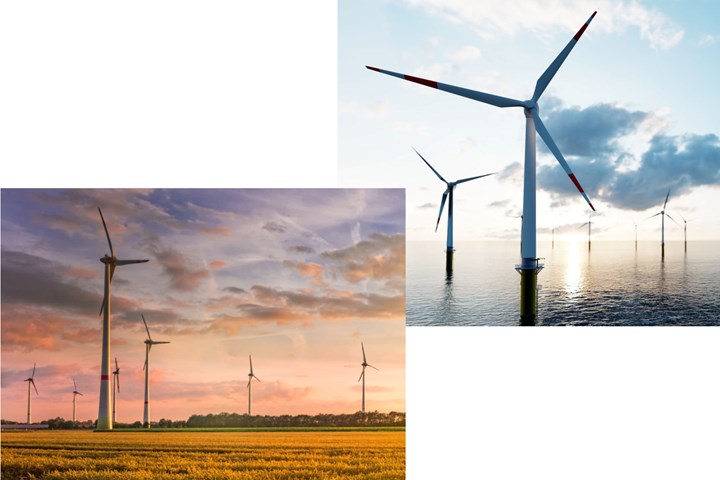North Sea countries target 260 GW of offshore wind energy; onshore wind shows reduced CO2 in U.S.
Nine EU countries agree to increased installations by 2050 for reduced CO2, a goal proven by a U.S. energy report, citing highest reductions in wind belt states.

As reported by North American Windpower, energy ministers from the nine members of the North Seas Energy Cooperation (includes Belgium, Denmark, France, Germany, Ireland, Luxembourg, the Netherlands, Norway, Sweden and the European Commission; the U.K. withdrew in January 2020) agreed to increase offshore wind deployment at their recent meeting in Dublin, Ireland. The new goal of at least 260 GW of offshore wind energy by 2050 will represent more than 85% of the EU-wide 2050 target of 300 GW.
“The green energy transition has only become more urgent since Russia’s invasion of Ukraine,” says Commissioner for Energy Kadri Simson. “The acceleration of renewables deployment is one of the three pillars of the REPowerEU Plan to end our dependence on Russian fossil fuels. Increasing renewable energy will not only help to improve the sustainability of our energy sector, it will improve our security of supply and the affordability of energy — two challenges that we are facing in the EU at the moment.”
“In Ireland alone, our sea area is seven times our landmass,” states Minister for the Environment, Climate and Communications Eamon Ryan. “The North Atlantic and North Sea comprise some of the windiest locations on the globe. It is our greatest collective resource of continuous energy, and it is momentous that we have agreed today to be ambitious in our targets, as a collective.” He noted the best way to realize that potential of offshore wind is to set agreed targets and operate as a collective. “With this approach, we can provide assurances to householders and businesses — in our own countries and across Europe — that firstly, Europe will be energy independent, and secondly, that these new renewable energy sources and resultant hydrogen from our seas will be fairly shared and, critically, will be affordable,” says Ryan.
North American Windpower also published highlights from the latest report by the U.S. Energy Information Administration (EIA), noting the carbon intensity of U.S. power generation fell 18% between 2016 to 2020, driven by a shift in the U.S. electricity generation mix away from coal and toward natural gas and renewables. The carbon intensity of power generation measures the amount of CO2 emitted to produce a unit of electricity. All but seven U.S. states decreased carbon intensity over that five-year period, although the amount varied state by state.
In 2020, the carbon intensity of U.S. power generation averaged 854 pounds of CO2/MWh, based on a carbon intensity of coal in the United States of 2,274 pounds of CO2/MWh, natural gas at 980 pounds of CO2/MWh and little to no emissions from nuclear, hydroelectric, wind and solar. The states with the lowest carbon intensities of power generation either have a large share of generation from renewables or a large combined share from renewables and nuclear. In 2020, Vermont had the lowest carbon intensity of power generation at 8.4 pounds of CO2/MWh, with almost all of its in-state electricity generation from renewables, but 60% sourced from Canada.
The five states with the largest reductions in carbon intensity between 2016 and 2020 (in pounds of CO2/MWh) were Tennessee (486), Maryland (477), Iowa (443), Kansas (371) and Oklahoma (348). Notably, the last three are located within the U.S. central wind belt.
Related Content
Plant tour: ÉireComposites, Galway, Ireland
An in-house testing business and R&D focus has led to innovative materials use and projects in a range of markets, from civil aerospace to renewable energy to marine.
Read MoreJEC World 2022, Part 3: Emphasizing emerging markets, thermoplastics and carbon fiber
CW editor-in-chief Jeff Sloan identifies companies exhibiting at JEC World 2022 that are advancing both materials and technologies for the growing AAM, hydrogen, automotive and sustainability markets.
Read MoreJEC World 2022, Part 1: Highlights in sustainable, digital, industrialized composites
JEC World 2022 offered numerous new developments in composites materials, processes and applications, according to CW senior editor, Ginger Gardiner, most targeting improved sustainability for wider applications.
Read MoreMaterials & Processes: Fibers for composites
The structural properties of composite materials are derived primarily from the fiber reinforcement. Fiber types, their manufacture, their uses and the end-market applications in which they find most use are described.
Read MoreRead Next
From the CW Archives: The tale of the thermoplastic cryotank
In 2006, guest columnist Bob Hartunian related the story of his efforts two decades prior, while at McDonnell Douglas, to develop a thermoplastic composite crytank for hydrogen storage. He learned a lot of lessons.
Read MoreComposites end markets: Energy (2024)
Composites are used widely in oil/gas, wind and other renewable energy applications. Despite market challenges, growth potential and innovation for composites continue.
Read MoreCW’s 2024 Top Shops survey offers new approach to benchmarking
Respondents that complete the survey by April 30, 2024, have the chance to be recognized as an honoree.
Read More












.jpg;maxWidth=300;quality=90)












